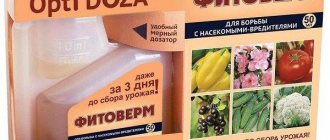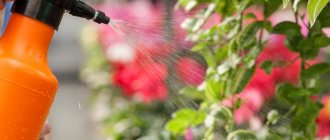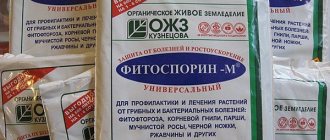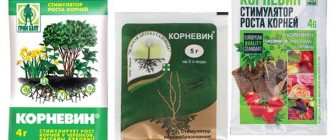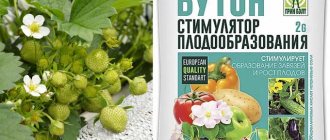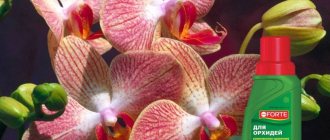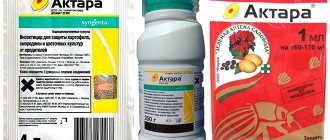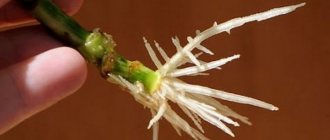Despite its completely natural composition, Fitoverm is a rather toxic product, which is assigned a third class of hazard to humans, so when working with it certain precautions must be observed:
- All manipulations with the drug are carried out wearing protective gloves, goggles and a respirator. Clothing should fit snugly to the body, covering all areas of it.
- To prepare the working solution, use only special containers. It is unacceptable to dilute the insecticide in dishes that could accidentally mix with kitchen utensils.
- During treatment, drinking, smoking and eating are prohibited.
- Do not spray near animals and small children, as well as in close proximity to ponds and aquariums.
- If the drug gets into your eyes, wash them with plenty of running water. The solution found on the skin is thoroughly washed off with soap and water. If Fitoverm is accidentally swallowed, you must immediately induce vomiting and then take several tablets of activated carbon (1 tablet per 10 kg of weight).
- At the end of the event, you should wash all containers that were used during processing and put them away from small children and animals. Be sure to wash the clothes in which you sprayed and take a shower.
- The product must be stored in a specially designated place strictly according to the instructions. The drug solution cannot be stored and must be used immediately after preparation. Do not use insecticide after the expiration date.
Fitoverm is a fairly popular biological drug that has proven itself to be positive. Its effectiveness in pest control is difficult to dispute, despite the presence of some disadvantages.
Instructions for use
General recommendations
The drug is applied to the plant by spraying as pests appear during the growing season of plants
Fitoverm treatment alone is not enough to completely destroy the pest. Repeated 2-3 treatments are recommended at intervals of 3-7 days, depending on the ambient temperature and the type of pest. Light precipitation, heavy dew, and low temperatures reduce the effectiveness of the drug.
The period of protective action is at least 7-20 days
Processing of vegetable crops
| Culture | Pest | Consumption rate of the drug | Consumption rate of working solution | Waiting period | Frequency of treatments |
| Potato | Colorado beetle | 4ml/1l.water | 4l./ 100 sq.m. | 1 day | 3 times |
| Cabbage | Cabbage and turnip whites, cabbage cutworm, cabbage moth | 8-16ml/1l.water | 3-4l./ 100 sq.m. | 2-3 days | 2 times |
| Cucumber, tomato, pepper | Spider mites, thrips, whitefly | 10ml./1l.water | 10l./ 100 sq.m. | 1-3 days | 3 times |
| Tomato, pepper, eggplant | Aphid | 8ml./1l.water | 10l./ 100 sq.m. | 3 days | 2-3 times |
Processing of berry and fruit crops
| Culture | Pest | Consumption rate of the drug | Consumption rate of working solution | Waiting period | Frequency of treatments |
| Currant | Spider and kidney mites | 2ml./1l.water | 1l. on the bush | 3 days | 2-3 times |
| Currants, gooseberries | Moths, leaf rollers | 1.5ml/1l.water | 0.5-1l. on the bush | 3-5 days | 2 times |
| Apple tree | Ticks, leaf rollers, moths | 1.5-2ml/1l.water | up to 5l. on the tree | 3 days | 1-2 times |
| Apple tree | Codling moth, cutworms | 2ml./1l.water | up to 5l. on the tree | 3 days | 1 time |
Processing of flower crops
| Culture | Pest | Consumption rate of the drug | Consumption rate of working solution | Waiting period | Frequency of treatments |
| Flower crops in protected soil | Thrips | 8ml./1l.water | 10l./ 100 sq.m. | 1 day | 3 times |
| Flower crops in protected soil | Aphid | 4ml./1l.water | 10l./ 100 sq.m. | 1 day | 2-3 times |
| Flower crops in protected soil | Spider mite | 2ml./1l.water | 10l./ 100 sq.m. | 1 day | 3 times |
| Open ground flower crops | Aphid | 8ml./1l.water | 10l./ 100 sq.m. | 1 day | 3-4 times |
| Open ground flower crops | Spider mite | 2ml./1l.water | 10l./ 100 sq.m. | 1 day | 4 times |
| Open ground flower crops | Thrips | 10ml./1l.water | 10l./ 100 sq.m. | 1 day | 4 times |
| Indoor flowers | Spider mite | 2ml./1l.water | 0.1 l./ 1 sq. m. | 1 day | 4 times |
| Indoor flowers | Aphid | 2ml/0.25l water | 0.1 l./ 1 sq. m. | 1 day | 4 times |
| Indoor flowers | Thrips | 2ml/0.2l water | 0.1 l./ 1 sq. m. | 1 day | 4 times |
The standards are based on the use of drugs with a concentration of the active substance of 2 g/l. "Aversectina-S".
Features of Fitoverm treatment of some indoor plants
When processing indoor flowers, you need to consider several points. If pests are found on one plant, it is necessary to inspect all the flowers in the house to avoid the risk of secondary infection. Tips for processing indoor flowers:
- Spraying with chemicals should be carried out 3-4 times every 7 days. The air temperature should not be lower than 25 ˚C. If the temperature is higher, then treatment should be carried out every 5 days. Treatment will be ineffective at temperatures of 18 °C and below.
- After spraying with a spray bottle, there is no need to put a plastic bag on the plant (orchids are an exception). It is much more important to re-spray on schedule.
- A single treatment gives only a temporary effect: flower treatment must be systematic.
Advice!
Plants need to be sprayed when they are dry. It is better to carry out the procedure during the day. Due to the fact that Fitoverm is a hazard class 3 drug, it is better to carry out the treatment on the balcony or in the fresh air. If you have to spray flowers indoors, the room must be thoroughly ventilated at the end of the procedure. To enhance the effect of Fitoverm, you can add potassium soap to the solution.
Violet
Indoor violets are most often attacked by thrips, aphids and mites. The entire flower needs to be treated, not just the affected areas. It is advisable to change the soil in the pot or thoroughly treat the old one with an insecticide. Before treating violets for pests, it is necessary to remove the flower stalks.
Processing violets
The solution must be prepared from 2 ml of Fitoverm and 1 liter of water. You can add a little shampoo or soap to the solution to enhance the effect. In total, you need to carry out 3-4 treatments, with an interval of 4 days. After spraying the violets, they need to be placed in a dark place so that the leaves do not become stained.
Orchid
Fitoverm is used in case of mite infestation of orchid stems and leaves. Processing algorithm:
- Remove the orchid from its pot and disinfect it. If possible, it is advisable to purchase a new pot to protect the flower from re-infection with parasites.
- Clean the orchid roots from the substrate. Afterwards, the root system should be washed with hot water and soaked in a container with Fitoverm solution (1 mg per liter).
Orchid processing - After processing, the orchid should be placed in a basin and the roots should be covered with a plastic bag for a day. You need to place the container in a place where sunlight will fall on the plant. The roots may begin to dry out, so they will need to be moistened if necessary.
- The treatment must be repeated after 10 days, and then the orchid should be planted in a new pot. You can water the flower after 5 days.
- The treatment of the flower is repeated 2 more times, and in this case the drug should not be applied to the leaves, but added to the soil.
Rose
Spider mites are most often found on roses. Treatment against the pest should be carried out in the fresh air, spraying the leaves on both sides with a sprayer. If some of the solution remains, it can be used to moisten the top layer of soil. Use a sponge soaked in a chemical solution to treat the window sill on which the rose pot stands.
Rose treatment
The parasites die after a few hours. To completely get rid of them, 3-4 treatments of the rose with breaks a week are enough. The average dosage of Fitoverm for roses is 2.5 ml per 1.25 liters of water.
Lily
Lilies need to be treated with a sprayer, which provides a fine spray of the solution. It is important to process the lily leaf plates on both sides. The duration of action of the insecticide depends on the type of pest. Gnawing ones begin to die after 6-8 hours, and sucking ones - after two days. The chemical shows its maximum effect after a week. After 20 days, lilies can be treated again. The dosage of Fitoverm differs depending on the lily disease:
- 4 ml per 2 liters against ticks;
- 4 ml per 1 liter against aphids;
- 4 ml per 0.5 liter for thrips.
Ficus
To spray ficus plants, set the sprayer to the finest setting. On average, to treat a ficus you will need 2 ml of the substance and 1 liter of water. This method is suitable for removing spider mites. Repeated treatment must be carried out after 4 days.
To remove thrips from a plant, 2 ml of the drug must be diluted in 500 water. In particularly advanced cases, you can take 300 ml of liquid. You need to spray not only the leaves, but also the top layer of soil. Number of treatments – 2, with an interval of 2 weeks.
Waiting times
- avermectins are quickly destroyed by sun and moisture;
- the decay period on the soil surface is a day, on plants – no more than 72 hours;
- half-life in water and soil is 1-7 days;
- the drug has low toxicity for bees; after evening treatment it becomes absolutely safe every other day.
The poison remains in the bodies of insects and ticks for 7-20 days. Even if they survive, they become less voracious and their ability to reproduce decreases.
The drug is safe for plants (non-phytotoxic) and does not accumulate in their organs. After spraying, the fruits can be collected and eaten after 48 hours.
Advantages and features of use
The advantages of using the drug are as follows:
- High efficiency in protecting plants from mites, thrips and other insects;
- Minimal impact on beneficial entomofauna;
- Suppresses pests on the upper and lower sides of the leaf;
- Enteric-contact mechanism of action;
- The long (up to 3 weeks) period of protective action allows for only 2-3 treatments;
- Does not have a phytotoxic effect on plants;
- Allows you to start harvesting vegetable products in protected soil 2 days after treatment;
- Does not leave stains on plants.
There are a number of features of the drug that must be taken into account when using:
a) Stability. The drug "Fitoverm" is photoinstable, since the substances "Avermectin" decompose very quickly under the influence of air and ultraviolet rays. Therefore, it is recommended to treat plants against insects better in the evening, in the dark.
b) “Fitoverm” refers to intestinal-type drugs, so there are some restrictions for insects that do not feed. When treating in greenhouses or other indoor areas, it is recommended to increase the temperature to speed up the feeding of the pest and the hatching of larvae from eggs. So, when processing indoor flowers, it is recommended to place them in plastic bags after spraying to increase the temperature and enhance the effect of the drug.
c) Compatibility. Fitoverm is compatible with most insecticides, acaricides and fungicides. The best combination is provided with hormonal drugs that interrupt the pest’s development cycle.
How to get rid of scale insects using folk remedies?
Flower growers have different attitudes towards folk remedies in the fight against scale insects. Many experts believe that the effectiveness of folk remedies is extremely low, and moreover, there is a risk of harm to the flower.
- According to the editors of the Flower Festival magazine, folk remedies for scale insects can be used in certain cases, since they are safer for humans and animals.
If the degree of damage to the plant is small and there are few pests, then it is better to start with folk remedies or if it is a plant that can be sacrificed, but there is no desire to buy insecticides because of it.
In any situation, the use of folk remedies is a personal choice for each person, but systemic insecticides are more effective.
1. Soap solution
To prepare the solution, you can take laundry, tar or green potassium soap, and, in extreme cases, any soap, as well as dishwashing detergent, will do.
- It is necessary to treat the entire houseplant with a soap solution, as well as the window sill, window frame, pot and pot tray. The more foam in the process, the better.
- After wiping the flower, it is better to wash off the soap suds after 2-4 hours.
If there are a lot of plants in the apartment and they have small leaves, then you can spray them with a soap solution to save time. The effect of the treatment will be lower, but not everyone has the patience or time to wipe.
When spraying, try not to let the soap solution get on the soil, especially on the roots of the flower. To do this, cover the soil in the pot with film.
RECIPE. Pour a tablespoon of soap shavings into a glass of warm water. To enhance the effect, you can add a teaspoon of ammonia (technical, medical, or, in extreme cases, vodka) and 300 grams of water.
The soap-alcohol solution must be washed off after 10-15 minutes with warm water so as not to burn your home flower.
IMPORTANT! Some experts insist that using soap solution on indoor flowers is not permissible. In their opinion, soap blocks the stomata of the plant, which leads to disruption of photosynthesis and plant development.
Plants with delicate leaves should not be treated with alcohol.
2. Oil
Beat 5-10 grams of soap in a glass of water until foam appears, add 15-20 ml of machine oil (2 tablespoons of olive or sunflower). The plant is washed completely with a soap-oil emulsion and left for 6-10 hours, and then washed off.
Carry out 2-3 procedures every 7-10 days. Before treating the plant, cover the soil mixture in the pot with film! Treatment with a water-oil emulsion is not recommended for plants with pubescent, delicate or very thin leaves.
3. Garlic
Pour a glass of water over five crushed cloves (a teaspoon of pulp) of garlic. Infuse the mixture in a tightly sealed container for 1-2 days, and then wash the plant every 7-8 days. To spray, strain the infusion through three layers of gauze.
Recipe No. 2. A teaspoon of garlic pulp (4-5 cloves crushed) is poured into 500 ml of boiling water and left for 4-5 hours. The infusion is filtered and the affected flower is wiped.
4. Onion
A medium-sized onion is finely chopped, mashed and poured with a glass of water for 2-3 hours. Then everything is the same as with garlic.
5. Pepper
Grind and boil 50 grams of fresh hot pepper in 500 ml of water, then leave for 24 hours and filter. To wash and spray the plant, 10 ml of infusion and 5 grams of household soap are mixed with a liter of water.
You can treat plants against scale insects with pepper once every two weeks. Pepper tincture can be stored for a long time in its finished form, which allows it to be used very quickly after detecting a scale insect.
6. Tobacco
Pour 80 grams of dry tobacco (shag) with a liter of water and leave for 24 hours, then strain and dilute with a liter of water. Then rinse and spray the plant.
7. Kerosene
In a liter of water, stir 40 grams of household soap (25 grams of green potassium soap) and add five drops of kerosene, and then shake the solution well. The mixture can be wiped or sprayed on the affected areas of the plant.
Description of the drug Fitoverm
Chemical and biological pest control products are available for sale. The latter are distinguished by their soft action and safety. They do not harm the environment and are only in some cases dangerous to bees and other beneficial insects. Fitoverm is a well-known biological insecticide. It can be used at home, in greenhouses, greenhouses and in open ground against many types of pests.
Fitoverm against aphids
Fitoverm has a contact-intestinal effect. Destroys larvae, caterpillars and adult insects. The active component is aversectin (2 g/l). This is a metabolic product of the Streptomyces fungus that lives in the soil. When it enters the insect's body or esophagus, it is absorbed into the tissue and attacks the nervous system, causing paralysis. The effect of the drug is not observed immediately after use, but affected individuals cannot survive.
Interesting! The Fitoverm insecticide can be used at different periods of the plant growing season. Thanks to this feature, gardeners often choose this particular product to kill pests on the site.
The drug is a liquid substance. An unexpired product will be clear, without sediment or turbidity. Its smell is pungent, unpleasant, and even after dilution, it does not go away. It is used to process a wide variety of plant species that grow in the garden or vegetable garden. It is also suitable for killing pests on indoor plants.
Fitoverm for spider mites
The product is available in bottles and ampoules. For indoor plants or small areas, you can purchase a 2 ml or 4 ml ampoule. This will be enough for one-time use. There is also Fitoverm in 5 ml ampoules - this is the most practical option. Well, for regular use or large plantations that need treatment, you can purchase the drug in 10-400 ml bottles or 1-5 liter canisters.
Large canisters, bottles or ampoules of Fitoverm are always accompanied by detailed instructions for use, which also outline safety measures and exact dosages so that the buyer understands how to dilute and how to use the drug.
Types of "Fitoverma" and analogues of the drug
The most effective analogues of this insecticide are:
- Akarin;
- Aktofit;
- Aktellik;
- Kleschevitis;
- Atkara;
- Spark bio;
- Agrovertin.
Foreign drugs such as Vermitec or Abacus are prohibited in Russia because they are too toxic.
They can be used for processing flowers.
Disadvantages of Fitoverm
When using an insecticide, gardeners often note its disadvantages.
Fitoverm against the Colorado potato beetle
- It is better not to use this product during flowering periods, so as not to harm the bees. The product may kill the bee or affect the taste and quality of the pollen. So bees will not pollinate treated crops.
- Before use, it is worth adding an adhesive to the solution, since the product hardly sticks to the leaves and drains quickly.
Important! Fitoverm simply destroys pests. It has no positive effect on plant development
When using it, there is no improvement in the taste, color of the fruit or an increase in the amount of yield.
- Do not use it in or before rain, otherwise the effectiveness will decrease.
- Fitoverm has an unpleasant smell. It is very sharp, repulsive and takes a long time to wear off.
- To completely destroy pests on plants, 2-3 treatments with Fitoverm are required.
- This product cannot be combined with chemicals.
Despite the obvious disadvantages, Fitoverm is often chosen by gardeners and gardeners. Indeed, among biological insecticides this is one of the best remedies. It completely destroys mites and aphids in just a week, and with repeated treatment it also copes with young individuals that have just hatched from eggs.
Prevention
Prevention of scale insect infestation coincides with preventive measures against other pests. It is very important to provide proper care (especially watering) and a suitable microclimate. Do not allow moisture to stagnate in the tray of the pot and excessive moisture in the earthen ball.
All indoor plants should be inspected every 1–2 weeks to promptly notice the appearance of scale insects.
Pests attack weakened plants. Therefore, you should fight diseases in time and feed the flowers with a sufficient amount of organic and mineral fertilizers.
Often a “relapse” of infection occurs after 2–3 months. You can talk about victory only after the insect is completely destroyed. It’s easier to do this if you know how to get rid of scale insects on indoor plants. To do this, you will need to use chemical and folk remedies, as well as create favorable conditions for the plant.
Mechanism of action and active substance
Since Fitoverm is a biological product, its active ingredient is made from the metaplasm of fungi living in the soil. Mushrooms belong to the genus Streptomyces. A substance called aversectin C is isolated from the metaplasm, which is the basis of the biological product.
When animals devour the leaves and shoots of a plant irrigated with a biological product, aversectin C enters the gastrointestinal tract of the pests and, penetrating through it into the cell tissue, begins to act after 12 hours. A paralyzed pest cannot move and, accordingly, cannot feed. As a result of exhaustion, the insect dies 72 hours after the product begins to act.
Treatment of indoor and other plants with Fitoverm against sucking insects and acarids has a somewhat slower effect, so the pests die no earlier than after 5-7 days.
Due to the fact that the effect of the product occurs through the stomach, the larvae do not die. To completely destroy all insects, at least three to four treatments will be required.
Did you know? Decomposition of an insecticide that gets into the soil occurs within 24 hours; in open space it disintegrates after two days. The decay period of other products is about a month.
Formulas, action, modifications
The active principle of Fitoverm belongs to avermectins - substances produced by the actinomycete fungus Streptomyces avermitilis. Avermectins are extracted from the mycelial mass of the fungus by ethanol (alcohol) extraction. A feature of avermectins is a dual nerve-paralytic effect on pests: they stimulate the release of γ-aminobutyric acid in neuronal synapses and at the same time block chloride transmission channels to dependent receptors.
The chloride current in the nerves is disrupted and the entire nervous system goes into disarray. This process is quite slow, but the resistance (persistence) of pests to Fitoverm develops with great difficulty. In practice, Fitoverm can be regularly used on plants for 5-6 years, without fear of breeding a resistant population of plants. And if this occurs, it is enough to switch to other pesticides for a year or two so that the susceptibility of pests to Fitoverm is restored.
Modifications of the active ingredient Fitoverma
However, Fitoverm has a very serious nuance regarding the users’ own safety: there are 2 series of modifications of avermectins, due to the so-called. spatial isomerism of molecules: Aij and Bij. In foreign preparations and domestic ones made from foreign raw materials, the active substance is avermectin Bij (on the left in the figure). Avermectins Bij are stronger, but more toxic (hazard class 2-3), accumulate in fruits and are approved for use in the EU only for inedible crops. However, “European-oriented” manufacturers have no hesitation in introducing them into widely advertised products for the garden and city.
In the Russian Federation, only Fitoverm based on avermectins Aij (center in the figure) is approved for use in individual households. It is produced by LLC NBC "Pharmbiomed" (right); extracted from strains of the producing fungus VNIISKHM-51 or VNIISKHM-54 bred in Russia. Fitoverm from Pharmbiomed can be safely used in a country house, garden plot or farm, while others (Letto, Plantafol, OptiRoza, Fitoverm from other manufacturers) are only suitable for inedible crops and indoor plants - they have a stronger effect on pests, but they should not be used Not recommended for fruits and vegetables. By the way, the inexpensive Pharmbiomedov’s Fitoverm also helps a lot against pests of open ground roses, see for example. video clip:
Release forms
Fitoverm for indoor gardening is available in concentrated emulsion (CE) ampoules of 2 and 4 ml. For use outdoors in bottles of 5, 10, 30, 50 ml of EC and 100, 200, 400 ml and in canisters of 5 liters of MP stock solution. For professional use - in the form of P powder. The content of the active substance EC is 2 or 10 g/l; MP – 2 g/l; P – 2 or 8 g/l. The MR 5 l and P formalities are not used in individual farms.
It is also undesirable to use MR, because It cannot be stored in opened packaging. Fitoverm CE can be taken from an unopened bottle with a syringe in parts, piercing the stopper with a needle, then the shelf life of the drug is not reduced. Fitoverm is stored and diluted according to the general rules for liquid biological products, see video:
How to dilute Fitoverm and method of application
Initially, the solution is prepared in a small amount of water. While stirring the product, you need to add liquid to the required volume, which varies depending on the disease and the type of plant. It is necessary to prepare the solution only if it will be used on the same day.
Dilution of the solution
You cannot prepare a solution from Fitoverm and other chemicals, but it is permissible to mix it with biostimulants. Before using the resulting solution, you should check the compatibility of the mixed drugs: if a precipitate appears in the solution, the drugs are incompatible. Flower processing can be done using a manual or mechanical sprayer.
Thrips
Thrips are the most common pests of ornamental crops. To combat them, you need to dissolve 2 ml of the drug in 200 ml of water. The flower needs to be sprayed with a spray bottle. You can also wipe the leaves of the plant with a sponge soaked in the solution.
The frequency of treatments depends on the size, age of the flower and the number of parasites on it. On average, 4 sprays will be enough to get rid of insects. The treatment interval is 5-8 days. The drug begins to act after 3-5 days. After the last spraying, the flower can be treated with the strengthening agent Epin.
Spider mite
To remove spider mites with Fitoverm, you will need to dissolve the ampoule in a liter of water. The maximum number of plant treatments is 4.
The procedure must be repeated after a week or 10 days. Orchid and ficus leaves should be wiped with a cotton swab dipped in a solution; other house plants can be sprayed with a spray bottle.
Aphid
Aphids most often infest indoor roses. To remove insects, two capsules of the product (8 ml) diluted in 1 liter of liquid are enough.
A solution of this concentration is suitable for all domestic plants on which aphids have appeared. Insects die after 2-3 days. It is required to carry out 2-3 procedures at intervals of a week.
Whitefly
To kill flying insects, the volume of liquid and chemical must be increased. Therefore, a whitefly solution must be prepared from 1.5 liters of water and 6 ml of insecticide. To remove the insect, two sprays are enough. The interval between procedures is a week. The effect of the drug is noticeable after three days.
Precautions when working with the drug
Fitoverm is assigned hazard class 3, that is, it poses a moderate danger to people and animals. If concentrated vapors are inhaled, it can cause a severe allergy attack, and if ingested, it can cause mild poisoning.
When it gets into the soil, it quickly loses activity and does not cause much damage. But do not allow the solution to leak into water bodies, as it is fatal to fish.
If you dropped the concentrate onto the ground, sprinkle the area with sawdust, peat or sand and pour it with a 5% solution of soda (or any other alkali).
When working with the drug, you should use a full set of protective equipment: gloves, glasses, a scarf for the nose and mouth. After applying the insecticide, wash your hands and face with water and soap, and rinse your mouth thoroughly.
Do not eat, drink or smoke while spraying. The drug packaging is placed in a separate bag and then disposed of in the trash.
If poison accidentally ends up in the stomach, you should immediately drink 3-4 glasses of clean water and activated carbon at the rate of 1 tablet per 10 kilograms of weight. Then you should induce vomiting. If it gets into the eyes, wash them with warm water, trying not to close the eyelids.
If you continue to feel unwell, weakness, or nausea, you should immediately contact the hospital for professional help.
The biological product poses a threat to bees, so it is used with caution during the budding and flowering phase. But if you do the treatments in the evening, within 8-10 hours the solution is partially neutralized and is no longer so dangerous for striped workers.
Step-by-step instructions for use
It wouldn’t hurt every gardener to have Fitoverm at home. For indoor flowers, I use the preparation in 2 ml plastic ampoules. And this amount is enough for me to treat the plants on all the window sills of my three-room apartment.
So, the drug is a packaging bag containing a 2 ml plastic ampoule.
The ampoule is convenient for one-time use and safe to open. There are detailed instructions on the back of the package.
Since the photo is not very clear, I compiled a table of dosages of the drug Fitoverm:
So, we see that for indoor flowers against spider mites, the entire contents of a 2 ml ampoule must be dissolved in 1 liter of water.
Against aphids: 1 ampoule per 250 ml (0.25 l) of water.
Against thrips: 1 ampoule per 200 ml (0.2 l) of water.
Since in this case my gardenia is being eaten by thrips, I took a sprayer with a capacity of just 0.2 liters, poured settled water into it for irrigation and dissolved the contents of the ampoule there. Mixed well.
Having received the working solution, we go to war - treat the plants. Of course, if one flower is damaged, you need to treat not only it, but also all its neighbors. The safety instructions are written in the instructions:
I do not completely follow these rules, but in no case am I encouraging anyone to do the same. I usually process in a well-ventilated area, wearing gloves, I try not to inhale the fumes from the sprayer, I wash my hands and face, but I do without special clothing or a respirator.
You can spray the affected plants and water the soil in pots with the same solution, since some types of pests can also be found in the soil or lay larvae there.
After 7 days, it is recommended to repeat the treatment to consolidate the result.
It is worth saying that in the summer, preventive spraying with Fitoverm at least once a month is necessary, because this is the time of greatest activity and spread of all kinds of pests.
Reviews about the drug are mostly positive, many use it as first aid for their plants. He also helped me out more than once, and this time my gardenia was saved.
Don't forget that Fitoverm can also be used for seedlings of vegetables and flowers! This is very important during the seedling season.
19
Hazard class and precautions
Fitoverm belongs to the means of medium danger level. This means that when working with it, exposed skin and especially mucous membranes should be protected.
They cover their heads with a scarf, wear clothes with long trousers and sleeves, and hide their faces under a mask and glasses. In all manipulations with the drug, thick, waterproof gloves must be used.
It is better to carry out processing on an open balcony or in a well-ventilated room.
While spraying the solution, it is prohibited to eat, drink, or smoke. Signs of Fitoverm poisoning include nausea and vomiting. If the solution accidentally gets inside the body, you should immediately drink plenty of water with activated charcoal and cleanse your stomach.
The remaining solution is poured under the plants or into the toilet.
The unopened drug is kept in a dark and dry place where it is inaccessible to children and animals. Shelf life - 2 years.
The drug is compatible with bioregulators (Epin Extra, Zircon), organophosphorus insecticides and pyrethroids. It should not be combined with alkaline products and chemical pesticides.
A universal rule applies here: if you mix two drugs and observe precipitation, it means they do not mix well with each other .
Indications for use
Fitoverm helps to destroy most of the harmful insects that attack indoor flowers. The most dangerous among them are the following:
- Aphid. Green, yellow or black insects, the body length of which reaches 5 mm. In those areas of crops where the pest infests, stickiness increases, shoots and flowers begin to wither and wither, curl into a tube and become deformed.
- Thrips. The insect is so small that it is almost impossible to detect with the naked eye. Its presence can be determined only by the lightened dots - the results of its life activity on plants. They affect not only foliage, but also flowers with buds.
- Whiteflies. Small pests that weaken crops. In appearance they resemble small butterflies. They can be found on the inside of the leaf. After shaking the plant, the insects fly away in different directions.
- Spider mites. Another pest that covers the plant with a thin light cobweb. Foliage damaged by them loses its rich color, becomes covered with whitish spots and most often dies.
Doses for plants
This is how the drug “Fitoverm” is used. The instructions for use discussed above, as you can see, do not include too many steps.
One ampoule of the product usually contains 2-4 ml of the drug. The table below shows its dosage for popular plant species.
| Culture | Pest | Dose (ml/l water) | Periodicity |
| Pumpkin, tomatoes | Mite | 2 | As it appears |
| Thrips | 0.2 | 15-20 days | |
| Aphid | 0.3-0.5 | ||
| Apple tree | Ticks, leaf rollers | 1 | As it appears |
| Currant | Ticks, moths, leaf rollers | 1 | |
| Houseplants | Mite | 1 | |
| Thrips | 0.2 | ||
| Aphid | 0.25 | ||
| Cabbage | Caterpillars of armyworms and white moths | 0.5 |
As you can see, the dose is usually not too high. For some other plants, a stronger solution of the Fitoverm preparation should be used. The instructions for use for strawberries given above confirm this. The fact is that ticks on this plant, unlike bushes and fruit trees, are very difficult to remove.
In order for this drug to work, it must enter the insect's body. The pest must eat leaves during treatment. However, some insects feed periodically every other day. Therefore, after a couple of days it is advisable to carry out a control treatment. The above doses must be observed. This is a guarantee of operational safety and effectiveness of the Fitoverm drug. The instructions for use must also be followed exactly. Do not spray plants in cold weather or during the heat of the day.
